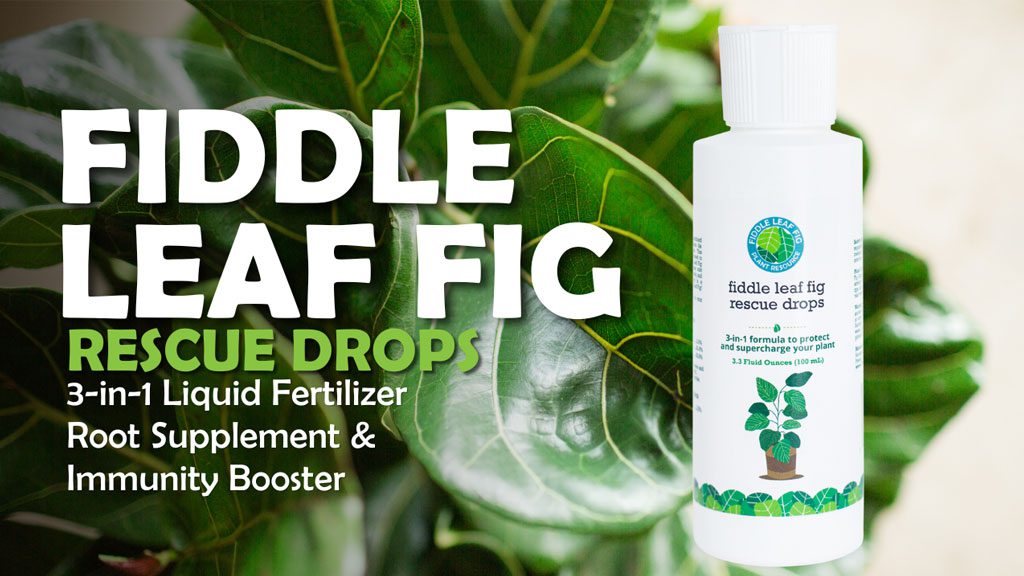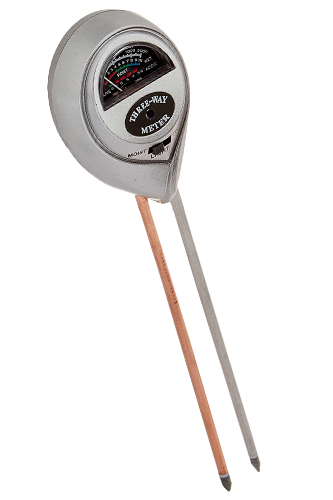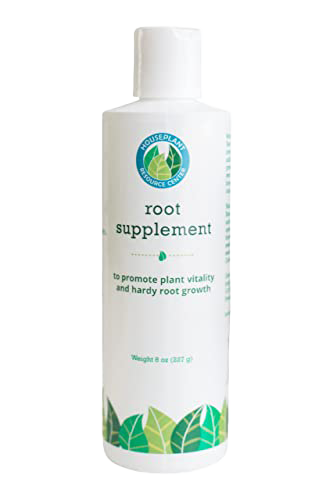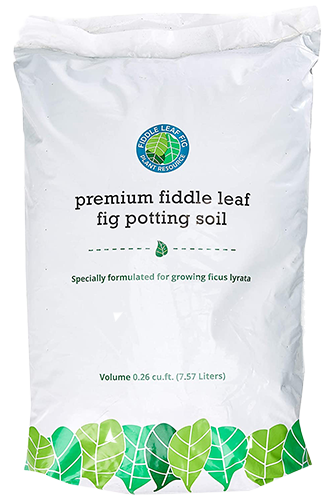Fiddle leaf figs are known for growing tall and beautiful indoors. But just how big do fiddle leaf figs grow, and at what rate? How can you help your fiddle grow taller and faster?
In this article, we’ll answer those questions and more so you can grow the big, beautiful fiddle leaf fig of your dreams!
How Big Does a Fiddle Leaf Fig Get Indoors?
How Tall Do Fiddle Leaf Figs Grow?
Fiddle leaf figs are fast-growing trees that can easily reach up to 60 feet tall outdoors and usually grow to about 10 feet in typical indoor spaces. But in a space with lots of light and high ceilings like an atrium or tall sunroom, a fiddle may grow much taller!
Keep in mind that there are also smaller varieties of fiddle leaf fig such as dwarf fiddles and bambinos. These trees may only reach 3-5 feet. Sometimes it’s hard to tell which variety you’re getting when you buy a plant at the garden center, but here’s how to tell the difference between a standard fiddle and a dwarf variety.
Fiddle Leaf Fig Growth Rate
Given the right conditions, including sufficient light and nutrients and the appropriate amount of water, fiddles can easily grow a foot or two each year indoors.
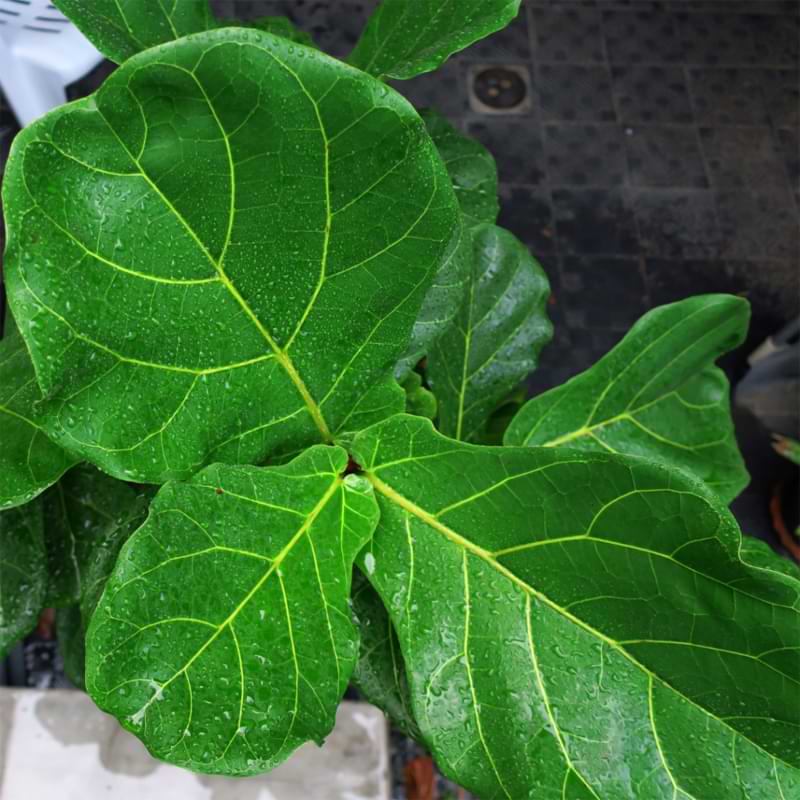
How Large Do Fiddle Leaf Fig Leaves Get?
One of the best parts of fiddle leaf figs—and the feature that earns them their name—is those big, beautiful leaves!
On a standard fiddle, leaves can easily grow to more than a foot long and almost a foot across at the widest point. On dwarfs and bambinos, leaves may only reach 6 inches long.
Large leaves on a mature fiddle are a sign of a healthy tree!
Fiddle Leaf Figs in the Wild
Natural Conditions
Fiddles grow in tropical and semi-tropical conditions. They’re native to the tropical rainforests of West Africa and can be grown in USDA Hardiness Zones 9-11. They like lots of bright sunlight and consistently moist (but not soggy) soil.
How tall do fiddle leaf figs grow in the wild?
Wild fiddle leaf figs can easily grow up to 60 feet tall with a thick canopy made up of thousands and thousands of large leaves. Temperatures in a fiddle’s natural habitat remain quite steady throughout the year and hover between 65-85 degrees Fahrenheit, dropping lower at night and higher during the day. Fiddles also love humidity, around 70% (though they do just fine with levels around 40% indoors).
How can I get my fiddle leaf fig to grow taller?
The best way to grow a tall, sturdy fiddle is to mimic its natural conditions as closely as possible. This means recreating the light, water, temperature, and humidity conditions your fiddle would enjoy in the rainforests of West Africa!
Luckily, this doesn’t have to be too hard. You can grow a tall, gorgeous fiddle indoor with the right care and maybe a few key supplies.
Position
One of the most important parts of raising a healthy, fast-growing fiddle is where you choose to put your tree. After all, this will determine your tree’s light, temperature, and humidity conditions, all of which play a huge role in a fiddle’s health and growth potential.
Fiddles also don’t like to be moved, if possible, so do your best to pick a suitable spot for your fiddle, and don’t be afraid to make a few modifications to adjust light, temperature, or humidity in that area to keep your fiddle happy.
Light
Light may be the single most important element to growing a tall fiddle leaf fig. Plants make energy from sunlight, and growing takes a lot of energy!
In the wild, fiddles typically enjoy full sun all day long. Indoor fiddles can be conditioned to tolerate full sun and will typically thrive when they do, but be sure to do this carefully so you don’t scorch the leaves. (Learn more about acclimating your fiddle to full sun here.)
Otherwise, indoor fiddles usually do best with lots of bright, indirect sunlight for at least 8 hours each day.
This means that an east-facing window may be the best place to put your fiddle because it may get some gentle, direct sunlight before 10 a.m. and lots of indirect light for the rest of the day.
A west- or south-facing window can also work really well, especially if your fiddle can tolerate full sun. (This is another great reason to acclimate your fiddle to direct sunlight—it really opens up your placement options!)
If your fiddle is not acclimated to direct sun and you want to place it near a south- or west-facing window, make sure to put it far enough from the window that the sun’s rays won’t fall directly on the leaves during midday or afternoon.
A north-facing window might work at certain times of the year and if the window is large enough, but most north-facing windows won’t provide enough sunlight for optimal health and fast growth for your fiddle.
But don’t worry, you have options! If you aren’t able to provide enough natural sunlight, you can supplement with full-spectrum grow lights. We love these grow bulbs you can just screw into regular light fixtures. So convenient!
Temperature and Humidity
Again, remember that you’re trying to grow a tropical tree here, so the more closely you can replicate the temperature and humidity conditions you’d find in the rainforest, the happier your tree will be.
Keep temperatures between 65-85 degrees Fahrenheit, and don’t let temps drop below 60 degrees or your tree may freeze.
70% humidity may not be achievable (or advisable) indoors, but your fiddle will be thrilled with humidity levels around 40-50%.
If you live in an arid climate or use a lot of indoor climate control, you may want to set up a humidifier near your tree or place smaller fiddles on a pebble tray to increase the ambient humidity. Grouping plants together can also help, as plants will raise the humidity level slightly with their respiration. Kitchens and bathrooms can also have higher humidity levels than the rest of the house, so those are great places to put plants if you have the room and sufficient light.
And, of course, make sure to keep your fiddle away from drafts, heaters, and vents that may scorch, freeze, or dry out the leaves.
Soil
Choose your soil carefully, because this will greatly affect your watering efforts.
Fiddles need a fast-draining soil because they don’t tolerate “wet feet” well and can easily develop root rot. On the other hand, you don’t want soil that dries out too quickly.
Choose a light, fast-draining soil with a bit of humus for the right amount of moisture retention.
Cactus soil can work well for fiddles, but we highly recommend our Premium Fiddle Leaf Fig Soil. This light, chunky potting mix drains beautifully and holds on to the right amount of moisture for fiddles. This soil is also a nutritional powerhouse to give your fiddle a boost of vitamins and minerals from day 1, and the neutral pH ensures that your fiddle will be able to absorb those nutrients as well.
Watering
Fiddle leaf figs enjoy evenly moist but not soaked soil.
Typically this means that you should water when the top 2-3 inches of soil feel dry to the touch. You can test this with your finger or a wooden stick like a chopstick.
However, we prefer to test the soil with a moisture meter, which can give you a much better idea of what’s going on deeper in the pot. (This is helpful because if your soil isn’t well-aerated, the root ball might still be wet even if the top layer of soil is dry to the touch.) When your moisture meter reads 3-4, your fiddle is ready for a drink!
This means you should be watering your plant every 7-14 days. If your soil dries out quicker than that, you might need to water more deeply. If the soil stays wet for longer, your fiddle may need more light or a soil that drains better.
Fertilizing
Growth requires nutrients, so make sure to fertilize your fiddle regularly starting a month or two after you pot it.
Go for a nitrogen-rich fertilizer, preferably something with an N-P-K ratio of 3-1-2. We prefer liquid fertilizers to slow-release sticks or pellets because it’s easier to control how much your plant is actually getting.
In fact, we created Fiddle Leaf Fig Food specifically for fiddles with an N-P-K ratio of 3-1-2. This fertilizer is easy to use and gentle enough to use with each watering so you don’t have to remember a fertilization schedule. After all, the best fertilizer is one you’ll use! Fertilize with each watering during the spring, summer, and early fall when your fiddle is most likely to be actively growing. You can take a break in the winter while your fiddle might be experiencing dormancy.
Pot Size and Repotting
Your roots need room to grow in order for your fiddle to grow taller, so make sure to choose a pot that’s 2-3 inches larger than your fiddle’s root ball. This will give your roots some room to branch out and grow, supporting your fiddle’s growth, but a pot this size won’t hold on to more water than your roots can absorb.
Plan on repotting your fiddle leaf fig every year and moving up a pot size when you do. This will allow the tree to keep growing and also refresh the soil for maximum nutrition and aeration.
Pruning and Shaping
Pruning your fiddle leaf fig can serve several different purposes. For one, it can improve your tree’s health by eliminating dead, damaged, or diseased material so your tree can redirect its energy toward new growth.
Pruning can also help you sculpt your tree into your desired shape. You know that iconic lollipop shape you see in all the Instagram photos? That shape doesn’t come naturally but requires careful pruning of the lower leaves as well as notching to encourage branching.
Staking Large Fiddle Leaf Fig Trees
So what happens if your tree grows tall but can’t support its own weight?
Staking can be a good temporary solution to keep your tree upright while you take other actions to strengthen and thicken the trunk.
To stake your tree, get a wooden or bamboo stake as tall as your fiddle’s trunk, carefully insert it into the soil close to but not touching the base of the tree, and use plant tape to secure the trunk.
But don’t stop there! In the meantime, make sure your tree is getting plenty of sunlight, the right amount of water, and plenty of nutrients and probiotics.
You should also make sure to “wiggle” your tree’s trunk regularly to simulate wind resistance and promote the tree to strengthen its trunk. It may sound weird, but it works! Learn how to do that here.
Common Problems That Prevent Healthy Growth
You might run into trouble on your quest to grow a taller fiddle. Here are signs to watch for and what to do if you see them.
Leaf Drop
Dropping leaves can be a sign that your fiddle is unhappy with something about its environment.
Make sure your tree is getting plenty of light and that the soil isn’t overly wet or dry. It’s also a good idea to check for insects, especially if you notice small brown or red spots on the leaves.
However, if your tree just drops a lower leaf every once in a while, this could be normal, healthy shedding of older leaves your tree no longer needs.
Learn more about treating leaf drop here.
Yellow Leaves on Fiddle Leaf Fig
Yellowing leaves on your fiddle can be a sign of overwatering, insufficient sunlight, or nutrient deficiency.
The best way to determine the cause is to use the process of elimination. First, check the moisture level of the soil. If it’s wet long after you watered, your soil may not drain well enough and/or your tree might need more light to use water more efficiently. (Yes, insufficient light and overwatering often go hand in hand!)
If the light conditions don’t seem quite bright enough (especially while seasons are changing, if the sun has moved), consider putting your plant somewhere else or using a grow light.
If light and water don’t seem to be the problem, ask yourself when you last fertilized or repotted. If it’s been a while, it might be time to fertilize!
Brown Leaf Tips
Leaf tips turning brown can be a sign that your plant needs more humidity or can indicate a watering problem.
If the spots on your leaves are dark brown, soft, and mostly occurring on the lower leaves, your plant may be overwatered and even have root rot.
If the spots are light brown and crispy, this could indicate low humidity or underwatering.
Dark Patches or Spots on Leaves
Dark spots on leaves usually indicate overwatering or sometimes a bacterial infection.
It can be difficult to tell the difference, but the good news is that the treatment for these conditions is the same.
Use clean hands and sterilized tools to carefully remove the diseased leaves, make sure the tree gets plenty of light, and go easier on the water. When you do water, use our Root Supplement to ward off further infection. If the spots are severe, repot the tree into a clean pot and fresh, fast-draining soil, taking care to prune off any rotting roots you see.
After that, put the tree in a bright place, let the soil dry out a little more between waterings, and use Root Supplement when you water.
Pests
Insects can also inhibit your fiddle’s growth by killing off the leaves, which the tree needs in order to make energy from sunlight.
Fiddles are somewhat susceptible to household pests like spider mites, mealybugs, scale, and fungus gnats. In general, you can use a hose or kitchen sprayer to rinse off insects (or pick them off with your fingernails, in the case of scale) and treat the plant with diluted neem oil or even insecticidal soap to kill off stragglers and prevent reinfestation. (You may need to use soap or neem oil a few times to eliminate different generations as the eggs hatch.)
Fiddle Leaf Fig: All Shapes and Sizes
Fiddles come in a few different varieties with different growth rates and different mature heights.
Here’s what you can expect from these fiddle varieties.
Ficus Lyrata “Bambino”
This is a small fiddle variety that only reaches 3 feet tall indoors. With the right care, this tree may grow between 6 and 12 inches each year.
Ficus Lyrata “Compacta”
Though larger than the bambino, this dwarf fiddle variety will max out at around 5 feet tall, growing about a foot per year.
Ficus Lyrata “Variegata”
The variegated fiddle should have the same maximum indoor height as the standard fiddle if it receives enough light. Variegated plants tend to grow more slowly, though, so this plant may only grow a foot per year, or possibly even less.
Grow a Happy Healthy Fiddle Leaf Fig
If you want a tall, striking indoor plant, fiddle leaf figs are an excellent bet! With the right care and conditions, they’ll reward you with lots of growth and beautiful leaves that will bring a sense of life and color to any indoor space.
If you have questions or need support for your leaning fiddle leaf fig, come join our online community by clicking below!


